

What Reflects a Great School? Not Test Scores - Education Week. Educate Yourself About Education. ADHD As A Difference In Cognition, Not A Disorder: Stephen Tonti at TEDxCMU. Staff. IEI Staff/Consultants & Board of Directors Contact Information Staff Biographies Richard W.
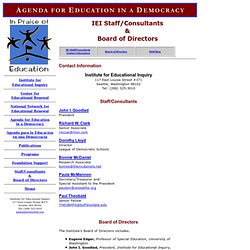
Clark is currently a consultant (and past executive vice president) with the Institute for Educational Inquiry. SCHOOL: The Story of American Public Education. SCHOOL: The Story of American Public Education. El_198503_quinby. El_198304_wiggins. TEACH: A New Documentary from Davis Guggenheim. The Traditional High School. For more than a century, American educators and education policymakers have chosen sides in a great debate about the nature and function of American high schools.
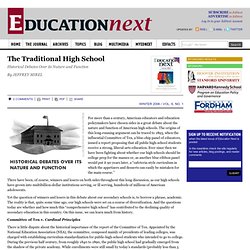
The origins of this long-running argument can be traced to 1893, when the influential Committee of Ten, a blue-chip panel of educators, issued a report proposing that all public high-school students receive a strong, liberal-arts education. Ever since then we have been fighting about whether our high schools should be college prep for the masses or, as another blue-ribbon panel would put it 90 years later, a “cafeteria-style curriculum in which the appetizers and desserts can easily be mistaken for the main course.” There have been, of course, winners and losers on both sides throughout this long discussion, as our high schools have grown into multibillion-dollar institutions serving, or ill serving, hundreds of millions of American adolescents. Committee of Ten v. Cardinal Principles. Global philosophies. A Brief History of Education in America. American Educational History Timeline. American Educational History: A Hypertext Timeline Last updated September 13, 2017.
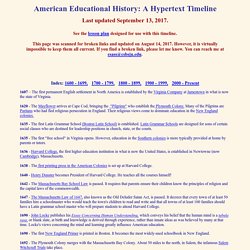
See the lesson plan designed for use with this timeline. This page was scanned for broken links and updated on August 14, 2017. However, it is virtually impossible to keep them all current. If you find a broken link, please let me know. 1607 – The first permanent English settlement in North America is established by the Virginia Company at Jamestown in what is now the state of Virginia. 1620 - The Mayflower arrives at Cape Cod, bringing the "Pilgrims" who establish the Plymouth Colony. 1635 - The first Latin Grammar School (Boston Latin School) is established. 1635 - The first "free school" in Virginia opens. 1636 - Harvard College, the first higher education institution in what is now the United States, is established in Newtowne (now Cambridge), Massachusetts.
History of education in the United States. Well equipped one-room school (with benches, blackboard, books, globe, stove, piano) in rural Oklahoma early 20th century The history of education in the United States, or foundations of education covers the trends in educational philosophy, policy, institutions, as well as formal and informal learning in America from the 17th century to today.

Colonial era[edit] New England[edit] SCHOOL: The Story of American Public Education. Historical Timeline of Public Education in the US. 1647The General Court of the Massachusetts Bay Colony decrees that every town of fifty families should have an elementary school and that every town of 100 families should have a Latin school.
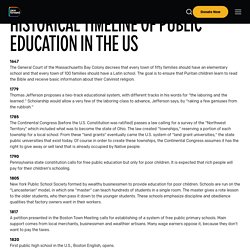
The goal is to ensure that Puritan children learn to read the Bible and receive basic information about their Calvinist religion. 1779Thomas Jefferson proposes a two-track educational system, with different tracks in his words for "the laboring and the learned. " Scholarship would allow a very few of the laboring class to advance, Jefferson says, by "raking a few geniuses from the rubbish. " 1785The Continental Congress (before the U.S.
Constitution was ratified) passes a law calling for a survey of the "Northwest Territory" which included what was to become the state of Ohio. 1790Pennsylvania state constitution calls for free public education but only for poor children. 1805New York Public School Society formed by wealthy businessmen to provide education for poor children. 1896Plessy v. TEACHguideFINAL.
GADOE. George Wood: Why Does Ohio Keep Changing the Rules for Judging Schools? George Wood is superintendent of Federal Hocking School District and an articulate supporter of public education in a state where public education is under siege by the governor and legislature.
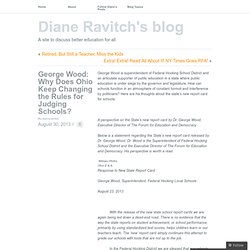
How can schools function in an atmosphere of constant turmoil and interference by politicians? Here are his thoughts about the state’s new report card for schools: A perspective on the State’s new report card by Dr. George Wood, Executive Director of The Forum for Education and Democracy Below is a statement regarding the State’s new report card released by Dr. William PhillisOhio E & A Response to New State Report Card George Wood, Superintendent, Federal Hocking Local Schools August 23, 2013. George Wood - The Forum for Education and Democracy. By George Wood, Superintendent of the Federal Hocking Local Schools in Stewart, Ohio; Executive Director of the Forum for Education and Democracy; Board Chair of The Coalition of Essential Schools The National Center for Educational Statistics says low-income children now make up 48% of the children attending public school.
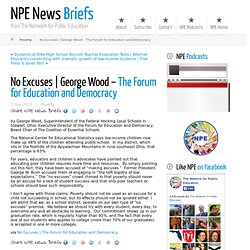
In my district, which sits in the foothills of the Appalachian Mountains in rural southeast Ohio, that percentage is 63%. For years, educators and children’s advocates have pointed out that educating poor children requires more time and resources. By simply pointing out this fact, they have been accused of “making excuses.” Former President George W. I don’t agree with those claims.
Animal School. Working in Groups.